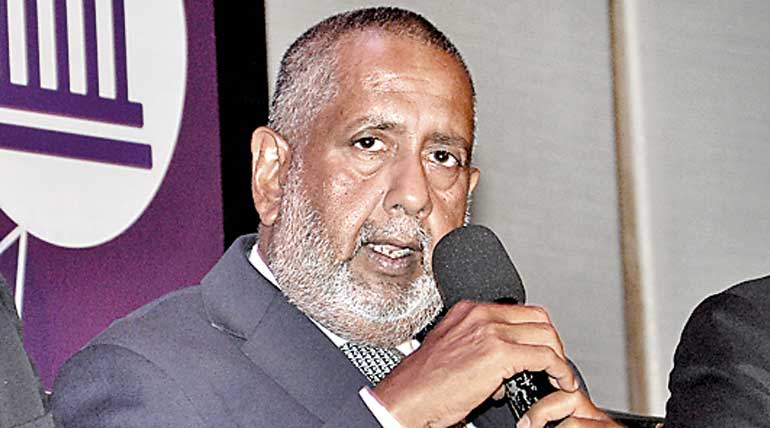Saturday Apr 26, 2025
Saturday Apr 26, 2025
Tuesday, 15 November 2016 00:19 - - {{hitsCtrl.values.hits}}
By Charumini de Silva
Confusion reigned on Friday at a post-Budget forum in Colombo over the actual amount the Government was planning to raise via the new Financial Transaction Levy (FTL).
In the 2017 Budget presented by Finance Minister Ravi Karunanayake on Thursday, a new Financial Transaction Levy (FTL) of Rs. 5 for every Rs. 10,000 cash transaction was proposed, including Easy Cash by banks and other financial institutions. This levy, Karunanayake justified was a contribution for social development. FTL will be treated as expenditure for income purposes.
Additionally, the Finance Minister also announced a fee of 2% on cash transactions above Rs. 5 million. This was to discourage cash transactions. However, the levy is not applicable on any transaction carried out through the banking channels including through cheques, telegraphic transfers, Bank drafts, etc.
 NDB Director and CEO
NDB Director and CEO
In the annexures to 2017 Budget, revenue earmarked from the FTL was put as Rs. 8 billion.
However, at the KPMG forum on 2017 Budget, veteran banker Rajendra Theagarajah noted that FTL could actually be looking at raking far more than the estimated figure.
He said that according to the Central Bank Annual Report 2015, Rs. 95 trillion goes through the Payments and Settlement System, including real time gross settlement (RTGS), and after applying 0.5% the number is around Rs. 47 billion, which is fairly significant in terms of contribution towards revenue.
“From a revenue point of view, the levy looks attractive but if there is going to be a charge then you are basically shaving off one half of the revenue from the systems,” Theagarajah cautioned.
However, in response Karunanayake said FTL was present to prevent any grey areas or danger elements on cash transactions which often occur with the help of professionals.
“Our intention is not to charge from one particular individual, but to broad base collections. For anybody who encashes more than Rs. 5 million, we have specified a fee. We don’t want to be like Modi and take Rs. 5,000 notes out of circulation,” Karunanayake added, referring to India’s unprecedented measure to curb money laundering by withdrawing the INR 1,000 and INR 500 notes from circulation.
The Government’s decision to direct banks to lend to specific sectors, almost collectively 50%, has caused concern in the financial services industry.
In presenting the 2017 Budget Finance Minister Ravi Karunanayake said: “I also directed banks to ensure that at least 10% of their lending portfolio is for agriculture, 10% for SME, 10% for exports, 10% for tourism, 5% for youth and 5% for women.
I further directed the banks to lend at least 15% of the deposits within the same area for business development.”
Veteran banker Rajendra Theagarajah at the KPMG forum on 2017 Budget questioned the prudence of directing banks to channel lending to specified sectors.
He highlighted that banking sector has a significant componet of institutional investors and having mandatory lending policies in banks often makes these large scale investors nervous. Hence, he requested clarity on the proposal.
In response Karunanayake said that bank licenses are given by the Government to do banking and not for unrelated activities.
“The proposal was a call from the banks to look at the Government policies and lend towards certain projects. That’s why we want to drive 50% of the lending book to specific areas. Every bank is posting a Rs. 15 b profit after tax (PAT), hence we want the banks to take a risk and spraed it out. It is not a mandate, but a request from the Government. It is a ‘may’ instead of a ‘shall’,” Finance Minister added. (CDS)
Discover Kapruka, the leading online shopping platform in Sri Lanka, where you can conveniently send Gifts and Flowers to your loved ones for any event including Valentine ’s Day. Explore a wide range of popular Shopping Categories on Kapruka, including Toys, Groceries, Electronics, Birthday Cakes, Fruits, Chocolates, Flower Bouquets, Clothing, Watches, Lingerie, Gift Sets and Jewellery. Also if you’re interested in selling with Kapruka, Partner Central by Kapruka is the best solution to start with. Moreover, through Kapruka Global Shop, you can also enjoy the convenience of purchasing products from renowned platforms like Amazon and eBay and have them delivered to Sri Lanka.
Discover Kapruka, the leading online shopping platform in Sri Lanka, where you can conveniently send Gifts and Flowers to your loved ones for any event including Valentine ’s Day. Explore a wide range of popular Shopping Categories on Kapruka, including Toys, Groceries, Electronics, Birthday Cakes, Fruits, Chocolates, Flower Bouquets, Clothing, Watches, Lingerie, Gift Sets and Jewellery. Also if you’re interested in selling with Kapruka, Partner Central by Kapruka is the best solution to start with. Moreover, through Kapruka Global Shop, you can also enjoy the convenience of purchasing products from renowned platforms like Amazon and eBay and have them delivered to Sri Lanka.